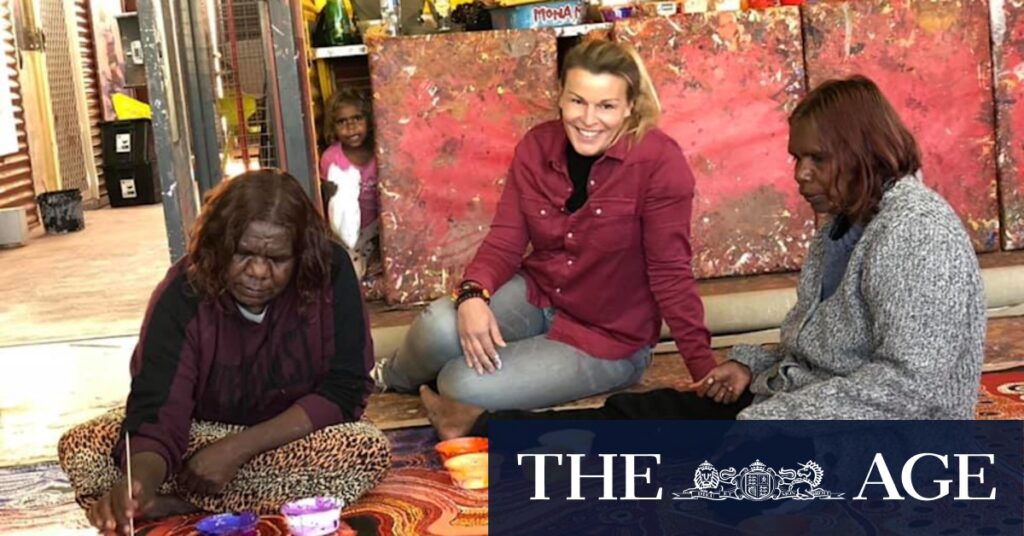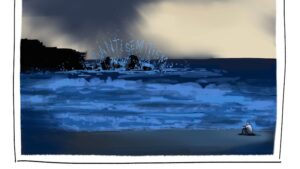
In the tranquil setting of Lens, Switzerland, a gallery nestled beside a shimmering artificial lake in the Swiss Alps is quietly reshaping the landscape of contemporary art in Europe. This gallery, with its elegant, light-filled architecture, houses artist residencies, a library, and exhibition halls, and serves as a cultural bridge between Australia’s First Nations artists and European audiences. At the heart of this transformative space is French-born, Swiss-based collector Bérengère Primat.
Primat’s journey into the world of Aboriginal art began two decades ago in a Paris gallery. What started as a visceral connection with Indigenous Australian paintings has evolved into one of the world’s largest and most significant private collections of contemporary Aboriginal art. “It was never a hobby,” she explains. “It is an obsession.” Her passion was ignited by the works of artists like Emily Kam Kngwarray, Clifford Possum, and Sally Gabori, whose art radiated a depth and energy that captivated her.
The Birth of a Cultural Bridge
Guided by curator Arnaud Serval, who had lived with Indigenous communities from a young age, Primat traveled to regions such as Alice Springs, the Kimberley, and Arnhem Land. Over 12 years, she immersed herself in Aboriginal culture, not as a mere collector, but as someone dedicated to honoring the artists and their stories. This dedication led to the creation of the Fondation Opale, a private, non-profit institution that stands as a testament to Primat’s vision to present Aboriginal art as a living and evolving contemporary practice.
The Fondation Opale, funded largely by Primat and supported by donors, aims to provide a platform where Aboriginal artists can express themselves freely. “What we do is contemporary art,” Primat emphasizes. “It’s not like the ancient art, even though the roots are deep inside those ancient culture and values. But it is contemporary.”
Building a Legacy
Primat’s roots trace back to one of Europe’s most influential industrial families. She is the great-granddaughter of Marcel Schlumberger, co-founder of the global oil services firm Schlumberger, and the grandniece of Dominique de Ménil, a prominent art collector and patron. By 2017, Primat had amassed over 1600 works, a number that has since grown to about 2000. However, it was a pivotal trip to the APY Lands in South Australia with her children that sharpened her purpose.
“We did five communities there,” she recalls, “and at the end, one of the artists told me, ‘There’s nowhere we can show our art in Europe which is not an ethnographic museum’.” When the Pierre Arnaud Foundation in Lens faced financial difficulties, Primat seized the opportunity to preserve and honor her collection by establishing the Fondation Opale.
Curatorial Excellence and Cross-Cultural Dialogues
The foundation’s exhibitions, such as “Beneath the Reflections of the World,” which pairs the late Queensland artist Sally Gabori with American painter Forrest Bess, reflect Primat’s commitment to cross-cultural exchange. “They break down artificial boundaries,” she asserts. Georges Petitjean, a trusted adviser and curator at Fondation Opale, has been instrumental in guiding Primat’s collection. Petitjean, who holds a PhD in Indigenous Australian art, praises Primat for compiling the “most interesting” collection on the continent.
Primat’s approach to collecting and exhibiting art is unique. Skye O’Meara, chief executive of the APY Art Centre Collective, highlights Primat’s commitment to ethical pathways and her focus on living artists. “She champions the careers of living artists, believing that they deserve recognition and support now, while they are working and innovating,” O’Meara notes.
Impact and Future Aspirations
Primat’s efforts have not gone unnoticed. Her work has inspired global institutions and major commercial galleries to pay attention to Indigenous Australian art. Even celebrity collectors like Steve Martin have taken an interest in this vibrant art form. Despite her achievements, Primat remains modest, focusing on the reception of the works and the impact on the artists’ communities.
“One lady told me, ‘I always feel very proud … but when I see what you have done here and how it is presented and exhibited, I feel even prouder,’” Primat shares. Her dedication to listening to the artists and ensuring their voices are heard is a testament to her commitment to cultural preservation and exchange.
As Fondation Opale continues to elevate Indigenous artists on the world stage, Primat remains focused on the future. “I’m always looking to the next step. What should I do? And I’m always, you know, asking myself: Am I doing the right thing? Is it really what is needed?” she reflects. Her journey is one of passion, respect, and a deep commitment to bridging cultures through art.
“Beneath the Reflections of the World,” featuring Forrest Bess and Sally Gabori, is on display at Fondation Opale until November 16.







